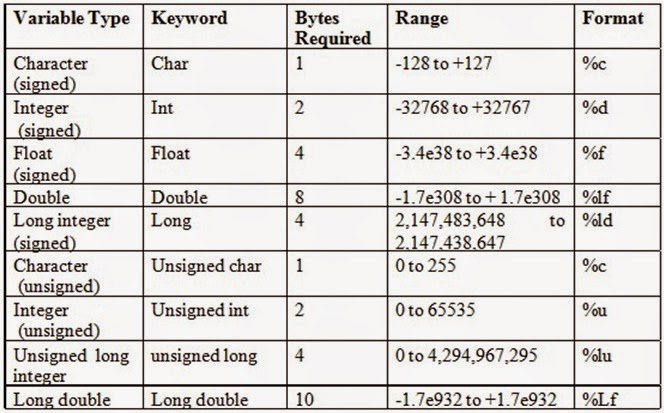
Instead, you will see a garbage value on the output screen. However, if you try to print float values with ‘%d’, then the output will not be 67 in the above case. As mentioned, float values are represented by the ‘%f’ format specifier. If you assign an integer value to a float variable, the result will always be a float value with zeroes after the decimal place. The output of the above program will be as given below: Average is 144.244019 Printf("Value of num presented as an integer %d \n",num) It will be clear for you from the example given below: #include A variable containing integer value will also be printed in the floating type with redundant zeroes. In C language, the float values are represented by the ‘ %f’ format specifier. The storage size of the float variable is 4 bytes, but the size may vary for different processors, the same as the ‘int’ data type. It is of two types:įloat variables store decimal values with up to 6 digits after the decimal place. The floating-point data type allows a user to store decimal values in a variable. For short int, an incorrect value will be displayed if the number is bigger than 10000. While doing an arithmetic operation, if the result comes out to be a decimal value, the variable will only accept the whole number and discard the numbers after the decimal point. The output of the above program will be as follows: a is 10000 Printf("a is %hd \n b is %d \n num1 is %ld \n num2 is %lld \n",a,b,num1,num2) Here is an example that will help you understand more about the concept. If you try to assign a decimal value to the integer variable, the value after the decimal will be truncated, and only the whole number gets assigned to the variable. The short data type takes 2 bytes of storage space int takes 2 or 4 bytes, and long takes 8 bytes in 64-bit and 4 bytes in the 32-bit operating system. The integer data type is further divided into short, int, and long data types. By default, the value assigned to an integer variable is considered positive if it is unsigned. In C language, the integer data type is represented by the ‘ int’ keyword, and it can be both signed or unsigned. But at the core, the C language has these four data types, which describe information used in your code.An integer type variable can store zero, positive, and negative values without any decimal. Obviously, a lot goes on with C data types, input, output variables, and all that. And you see, my name was stored and output. The F gets function at line 8, reads from standard input stdin up to 32 characters, storing them in the buffer. The name is buffer and it stores room for up to 32 characters.

#Basic data types in c code
This code declares an empty character array at line 5. Instead, an array of characters represents a string. Unlike other programming languages, C has no string data type. This type comes into play for allocating memory and referencing functions that return no value or accept no arguments. The void data type is also available, void for no data. Small value one quarter, and the large value, let's do 2.56e12. The information just goes in and it comes back out. The second is the address of the specific variable. The first argument in the function is the data type.

The scanf functions in the main body of the code, read the input of the different types.

Lines 5 through 8 they are characters C, integer I, float F and double D. In this exercise file, Four data types are listed. For example, the signed qualifier is the default, meaning that an integer value stores both positive and negative numbers, an unsigned qualifier means the integer stores only positive values. These data types also have qualifiers which can refine the data's scope. And a double is a double precision value accurate to 16 digits. A float is a single precision value, accurate to 8 digits. Char, to store a single character or byte of information, Int, to store integer or whole number values, and float and double to store real numbers, Which are fractions, are very large or very small values. The four basic C data types are shown here. The data type describes what kind of information is used in your code. In the C language data is classified into four types. The stuff that's input, modified and output is data. Input is received, modified, and then output.

The old IO, you sing about at computer camp.


 0 kommentar(er)
0 kommentar(er)
